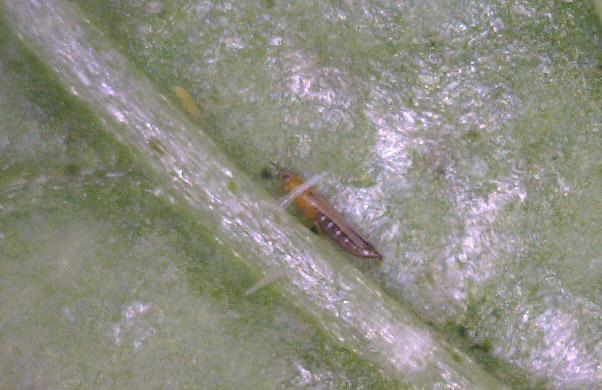Written by Geoffrey Njue, former SDSU Extension Specialty Crops Field Specialist.
Major insect and mite pests in high tunnels include aphids, thrips, white flies, and spider mites. Biological control uses living organisms (natural enemies) to suppress or limit pest populations to levels that do not cause economic injury to the crop. When using biological control it is important to inspect or monitor your plants at least twice a week to detect the pest early before they reach damaging levels. To do so, choose plants randomly throughout the high tunnel and look at all plant parts for the presence of insects and mites. Count the pests on specific parts of the plants and specific locations in the high tunnel. This will help you in your pest control decision making process. Colored sticky cards are a common method to detect and monitor for flying insects (e.g. white flies). Sticky cards should be positioned just above the plant and raised as the crop grows. Avoid the use of pesticides in the high tunnel when using biological control because most are toxic to the beneficial organisms.
A wide variety of biological control organisms are available from biological pest control companies. Consult your biological pest control company representative or distributor for the correct rates and approach to apply a biological pest control organism in your high tunnel. Check to make sure that the biological control organism is permitted for use in the state.
Below are the four most important insect and mite pests in high tunnels.
Aphids

Aphids can cause severe damage to high tunnel crops because of their enormous reproductive capability and wide host range. Females of many aphid species do not have to mate in order to reproduce. They produce live young rather than eggs. The young aphids (nymphs) are born and immediately start feeding on sap and grow quickly to become adults. Both nymphs and adults feed on plant sap which interferes with growth causing curled leaves and some discoloration of the foliage. They also secrete honey dew which leads to development of sooty molds. In some instances aphids can also transmit viral diseases.
The most commonly used biological control organisms for aphids include:
- Lady bird beetle (Adalia bipunctata). Lady bird beetles can be used to control many species of aphids of all stages. Adalia lady bird beetles have large and aggressive appetite. Apply lady bird beetles to infested leaves where most aphids are present. Adult lady bird beetles and larvae eat the aphids completely. Eggs are laid in aphid colonies. After emerging the larvae will search for aphids
- Parasitic wasps (including Aphidius Colemani and Aphidius matricarie) . The female adult parasitic wasp parasitizes the aphid by laying an egg in the aphid. The Aphidius larva starts eating the aphid from inside. The parasitized aphid swells and hardens into a leathery growth or brown mummy and the adult wasp emerges through a hole at the rear of the mummy.
Spider Mites

The two spotted mite is the most important pest in high tunnels. Because of their great reproductive capacity they can cause enormous damage in a short period of time. Spider mite larvae, nymphs, and adults feed on the underside of leaves causing yellow spots. With heavy infestation, leaves turn yellow which results in decreased plant growth and production.
The most commonly used biological control organisms for spider mites include:
- Predatory mite (Neoseiulus californicus). Adult predatory mites actively search for spider mite larvae and nymphs and feed on the internal fluids of the prey. They can also survive on other mites and pollen.
- Predatory mite (Phytoseiulus persimilis). This predatory mite can only survive on two spotted spider mite. The adults and nymphs of the predatory mite search actively for their prey and feed on the internal fluids of the prey.
Thrips

Thrips can be a major pest in high tunnels especially on cucumber and peppers. They cause damage by piercing and sucking out cells on leaf surface. This causes silver grey spots on leaves and at high infestation levels the leaves may wither. Thrips infestation reduces plant production and may also transmit viruses, especially tomato spotted wilt virus (TSMV).
The most commonly used biological control organisms for thrips include:
- Minute Pirate bug (Orius laevigatus, Orius insidiosus, and Orius tristicolor). Adults and nymphs of Orius species pierce thrips larvae and adults with their piercing-sucking mouth parts and remove the pest’s internal fluids. In the absence of thrips, Orius can survive on aphids, spider mites, and pollen.
- Predatory mite (Neoseiulus cucumeris). This predatory mite eats hatching eggs and first larval stage of thrips. They also eat spider mites, honey dew, and pollen. They work best at 75% relative humidity and 68°F.
- Predatory mite (Amblyseius swirskii). The adult A. swirskii predatory mite may search or wait for prey to feed on. Prey includes thrip and white fly larvae.
White Flies

Both adult and larvae white flies extract food from the plant which reduces production. The larvae secrete honey dew on which molds develop. They can also transmit viruses.
Common biological control organisms for white flies include:
- Parasitic wasp (Encarsia formosa and Eretmocerus eremicus). The female adult parasitic wasp parasitizes the larvae of the white fly. After about 2 weeks, the first parasitized whitefly pupa turns yellow or black. The adult parasitic wasp emerges from the pupa through a round hole. Erectmocerus parasitic wasp works best at temperatures above 68°F.


